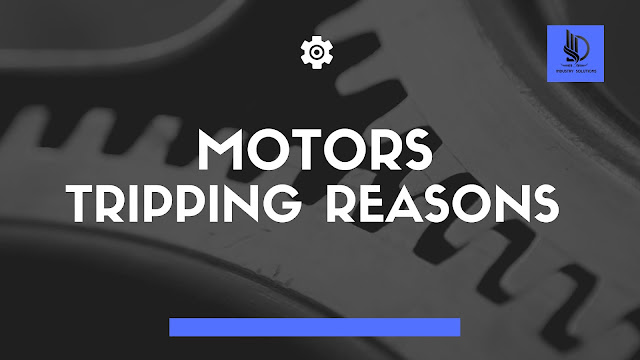Top Motor Tripping Reasons and Troubleshooting Guide
Unexpected equipment shutdowns are among the most frustrating issues in industrial environments—and one of the most common causes is motor tripping. Understanding the root motor tripping reasons is essential for ensuring uninterrupted operations, safety, and efficiency. In this comprehensive guide, we’ll explore the most frequent causes, how to troubleshoot them, and ways to avoid them through better monitoring and motor maintenance practices.
What Is Motor Tripping?
Motor tripping occurs when an electric motor shuts down
unexpectedly due to a protective device reacting to abnormal conditions. These
protections include overload relays, circuit breakers, thermal sensors, and VFD
fault codes. The goal of such tripping is to prevent damage to the motor or
system.
Main Electrical Motor Tripping Reasons
1. Overload Condition
Overload is the most frequent reason motors trip. It happens
when the motor draws more current than its rated capacity for a prolonged
period.
Causes:
- Increased mechanical load
- Misaligned coupling or shaft
- Dirty or jammed equipment (e.g., conveyors, fans, pumps)
Troubleshooting:
- Check for mechanical obstructions.
- Measure the motor's current draw using a clamp meter.
- Compare it with the full load current (FLC) on the motor nameplate.
- Adjust the overload relay to match the motor's rating.
2. Phase Loss or Single Phasing
When one phase of the power supply fails or disconnects, the
motor continues operating on two phases, drawing high unbalanced current.
Symptoms:
- Loud humming sound
- Reduced torque
- Overheating
Troubleshooting:
- Inspect connections at the motor terminal and MCC panel.
- Check fuses and circuit breakers.
- Use phase monitoring relays for early detection.
3. Voltage Imbalance
A voltage imbalance of more than 2–3% between phases can
cause excessive current on one winding, leading to overheating and tripping.
Diagnosis:
Use a multimeter to measure voltage between all three phases.
Troubleshooting:
- Ensure balanced loads across all phases.
- Check for loose connections or damaged cables.
4. Ground Faults and Short Circuits
These cause instant tripping by the breaker or ground fault
relay to avoid serious equipment damage or fire.
Common causes:
- Moisture inside motor windings
- Damaged insulation
- Cable wear or abrasion
Troubleshooting:
- Perform an insulation resistance test (megger).
- Dry the motor windings.
- Replace damaged wires or insulation.
5. Incorrect Protection Settings
Many motor tripping issues stem from incorrectly configured
overload relays, MCCBs, or protection modules in VFDs.
Troubleshooting:
- Review the motor datasheet and protection device settings.
- Consult the manufacturer’s manual for correct trip parameters.
Mechanical Causes of Motor Tripping
1. Bearing Failure
Worn or seized bearings increase mechanical load and cause
excess current draw.
Signs:
- Unusual noise or vibration
- High motor body temperature
- Shaft movement not smooth
Troubleshooting:-
Replace damaged bearings immediately.
- Schedule periodic inspections.
2. Shaft Misalignment
Misalignment between the motor and driven equipment causes
vibration, mechanical strain, and even overload tripping.
How to detect:
- Use laser alignment tools or dial indicators.
- Look for excessive vibration near couplings.
Fix:
- Re-align the shafts properly using precision alignment tools.
3. Locked Rotor or Stalled Load
A jammed pump, conveyor, or mixer can stop the rotor from
turning, causing the motor to draw locked-rotor current and trip immediately.
Troubleshooting:
- Manually rotate the driven equipment (if safe).
- Remove obstruction or clean mechanical parts.
- Check for gearbox or coupling damage.
Motor Tripping Due to Control System Issues
1. Faulty Starters or Soft Starters
Old or malfunctioning motor starters may not maintain stable
operation, causing nuisance trips.
2. VFD (Variable Frequency Drive) Trips
If the motor is controlled by a VFD, it may trip due to:
- Overcurrent
- Overvoltage/under voltage
- Motor temperature feedback error
- Internal component failure
Troubleshooting:
- Read the fault code on the VFD.
- Refer to the VFD manual to identify the cause.
- Check supply voltage, load, and motor parameters.
Smart Use of Protection Devices to Avoid Unwanted Motor Tripping
Protection relays and devices are essential for preventing
damage, but improper configuration leads to unnecessary downtime.
Key Devices to Know:
- Thermal overload relay
- Magnetic MCCB
- Earth fault relay
- VFD Protection functions
Read more: Synchronous vs Asynchronous Motors: Full Comparison
Step-by-Step Guide to Troubleshooting Motor Tripping
1. Check Trip History or Indicator Lights
2. Measure Supply Voltage and Current
3. Inspect Physical Components
4. Test Insulation Resistance
5. Check Mechanical Load
6. Reconfigure Protection Settings if Necessary
How to Prevent Recurrent Motor Tripping
- Use surge protection and voltage regulators.
- Install motor monitoring systems.
- Apply scheduled motor maintenance.
- Use data loggers on VFDs to analyze trends before failure.
When to Replace the Motor Instead of Repairing
Sometimes, repeated motor tripping is a sign that the motor
has reached the end of its life:
- Insulation resistance is consistently low
- Multiple windings have failed
- Shaft or rotor shows mechanical wear
Conclusion
Understanding the various motor tripping reasons is key to
maintaining efficient and reliable operations in any industrial facility.
Whether it's an electrical fault, mechanical issue, or configuration error,
each tripping event is a signal that deserves attention.
By applying a structured troubleshooting approach and investing in regular
motor maintenance, plant managers and technicians can greatly reduce downtime,
cut costs, and extend equipment life.




Comments
Post a Comment